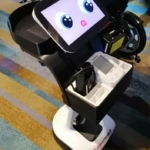Automation of hospitals with a focus on patient rooms is a very important, as this is where patients recuperate, so the environment must be good.

The need to minimise patients’ exposure to other persons especially during the COVID-19 pandemic, younger as well as some older generations of patients who are tech-savvy, have driven demand for such automation in hospitals.
However, patient rooms in most hospitals currently have traditional equipment with a control unit with all the cords and switches individually housed in a panel behind each bed, which is very important for the patient to be able to trigger an alarm in case of an emergency, summon the nurse and so on but such equipment tends to operate standalone.
There basically are three types of patients:-
- Patients who can move around by themselves but are hospitalised for whatever reason.
- Those who are completely immobile, so cannot move at all, such as those in a coma or are totally paralysed.
- Those who cannot walk but and move their head, are still conscious and alert, and can use mobile devices
So how to modernise and automate patient rooms to become smart, integrated patient rooms so they can better help all patients?

“One of the technologies which contribute to smart, integrated patient rooms is smart control solutions”, said Mr. Wang Swee Lee, an independent consultant and technology advisor in the hospitality, healthcare and senior citizen home industries. He also has over 42 years of experience in telecommunications, information technology, multimedia building intelligence, smart control technology and AI.
First is to have a control system which lets patients turn on and off lights, open and close the curtain, control the room temperature and so forth either by voice command or through a mobile app on their smartphone. However, such smart controls do not replace existing manual controls but optionally compliment them.
Also, facilities which help patients feel more comfortable, help them recover sooner, such as the house station behind each bed which communicates with the nurse central station and it’s most important that the nurse central station should can monitor everything which happens in the room – namely the room status.
Besides all the patient-manageable aspects such as lighting, curtains, temperature and so forth is monitoring of the air quality and humidity in the room.
“However, I’m not sure if hospitals in Malaysia monitor the air quality and other parameters in rooms. Instead, I believe that in some of the lower cost wards do not have these features but are just regular rooms with a bed” said Wang.
Sensors are used to monitor parameters such as air quality, carbon dioxide levels, humidity and so forth,, similar to those used in home monitoring systems, but for patient rooms, more elaborate sensors are required which are integrated into the hospital system and can let all these conditions be viewed from the nurse station.
For example, when a patient triggers an alarm, the nurse will see a flashing light at the nurse station and know which patient triggered the alarm and this can be enhanced further with a panel hanging in the corridor which displays which room triggered the alarm, what time and for how long it was triggered, so any nurse who walks past can immediately see the alarm and go into the patient’s room without having to wait for the nurse at the nurse’s station to come over, which is more efficient.
There could be a panel outside the door, which with a simple room, will have the patient’s name, the name of doctor attending to the patient, the room number and whether the alarm was triggered or not. If the alarm was triggered, the panel would show staff outside the room that it was triggered and when. If the room is occupied by three or four patents, the panel will indicate which patient it was and indicate the doctor attending to that patient.
“I don’t see such facilities in Malaysian hospitals, where the rooms have traditional patient facilities such as a cord with a button which patients press in case of an emergency” said Wang. “Also needed is an alarm which can be triggered by a patient in the bathroom, where if the patient falls down, he or she can press a button or pull a cord to summon help”, said Wang.
“All these alarms should be visible on the nurses station, the most important part of the entire integrated patient room, and these are the basic features of smart integrated patient rooms”, Wang added.
Robotic assistance
Besides smart, integrated patient room monitoring, there are several types of robots which can support patient care, both within patient rooms and the wider hospital premises.
Typically, patients arriving at hospitals would first go to the front desk to register before being admitted and assigned to bed in a patient room.

Here, a robot at the entrance or at the front desk can greet the patient and make them feel good, read their temperature in different ways depending on whether they are mobile or immobile, use facial recognition to determine whether or not patients are wearing a mask, and if not to tell them to wear a mask, all of which also helps to minimise the risk of exposure to the risk of COVID-19 infection between patients and hospital staff.

Once a patient has registered, the same or another robot can guide and accompany the patient to his or her room, and patients with premium or VIP rooms can also have a companion robot which assists them in their rooms.

“For example, when the patient tells the companion robot that he or she wants to watch TV, the robot which is fitted with a large display screen will come up close to the patient, so he or she can watch TV on the screen. If the patient wants to call his or her daughter, the robot can set up a voice or video call to the daughter”, said Wang.
Also, if the patient tells the companion robot to open or close the curtains, set the room temperature at 20 degrees Celsius, turn on or off the toilet light, the robot will instruct the room control system to perform these tasks as instructed. The companion robot can also see the patient’s facial expression and can smile or speak encouraging words or tell a joke to cheer the patient up.
If the patient is mobile, the companion robot can guide and accompany him or her to the lab where blood and other tests are conducted.

There are many hospital applications of robots, with the common ones being for a robot to bring doses of medicine to patients at specific times, delivering meals to patients at meal times.

There also are robots at physiotherapy centres which take a 3D image of the patient to know the patient’s physical condition. Using facial recognition and knowing their body size, weight, height and other parameters, the robot will understand the patient, and using use artificial intelligence (AI), will guide patients through the required massage and physiotherapy exercises through an exercise video. There also are robots which can massage patients.
“This is an extension of smart mirrors, used by many people especially in the U.S. during the height of the COVID-19 pandemic, where a program within the smart mirror guided people through certain exercises without them having to go to the gym. Now they have incorporated these smart mirror functions into robots which can move around”, said Wang.
If a VIP patient wants to do exercises, the nurse can bring a robot to the room to assist the patient to exercise. This also is to support physically disabled patients and senior citizens who are not mobile.
There also are robots which transport used bed linen placed by cleaning staff in bins on hospital floors to the laundry to be washed, robots which transport medicines from the hospital pharmacy to nurse stations in each ward or sections of each ward.

Other robots such as Temi designed by an Israeli company, is a multi-purpose, video-oriented, autonomous personal AI assistant robot, which when used in healthcare, serves as a guidance and delivery robot which carries blood pressure measuring and other kinds of medical diagnostic equipment for use by doctors or nurses in patient rooms, medical clinics and medical diagnostic labs. Temi can also guide patients in physiotherapy exercises.

Also ultra-violet(UV-C) sanitation robots can enter areas such as patient rooms with patients with infectious diseases which are off-limits to most people to minimise their risk of infection.
According to Malaysia’s Ministry of Health, UV-C radiation has wavelengths between 200 and 270 nm (nanometres), and at particular wavelengths such as 253.7nm and 254 nm, it can destroy the molecular bonds and disrupt DNA or RNA via pyrimidine dimerisation, causing death of a variety of micro-organisms (such as the Sars-Cov-2 virus responsible for COVID-19).
For physically disabled people, there are robots in shower rooms. These are fixed robots with adjustable positions for patients to sit on and be safe and secure whilst being showered by the robot.
These are common types of robots used in hospitals to help patients be more comfortable and help them to recover faster.

Besides these, main hospitals also have surgery and other kinds of precision robots which are very complicated machines which require doctors to be highly trained and skilled to operate, for example, to ensure that they make the incision at the exact place, which is rather complicated.
“Currently, surgery robots are already used in the United States and Europe but they are not as widespread since they are still expensive”, said Wang.
“However nowadays, hospitals have become very competitive and lots of private hospitals in Asia, where governments encourage medical tourism which is one of the major income earners for many countries. So these hospitals have to ensure that their rooms are excellent because the price of patient rooms are as much as those of five-star hotel rooms today, so hospitals must make sure they are up to standard”, Wang added.
In the future, could hospitals be star-rated like hotels? “That’s possible but so far, I have not heard of star-ratings for hospitals”, replied Wang.
“However, U.S. hospital prices are already very expensive and I have a friend who says he can afford to come to Asia for medical treatment but cannot afford treatment in U.S. hospitals which are too expensive.
“Also, doctors and everything else in the U.S. and Europe are expensive and labour costs are high, whilst the skills of doctors in Asia today are on par with doctors in the U.S. and Europe, and Asian doctors have performed operations which U.S. doctors haven’t done. So, I believe that hospitals in Asia are more advanced in terms of their setup and administration, with well-trained doctors.
“When I first went to China in 2002, I was surprised that hospitals there were already automated. When I had to go to a hospital there, I went up to a machine, took a number and went to the counter where I paid the fee, then went to the doctor who examined and diagnosed my illness and keyed it into his computer.
“I then walked to the pharmacy, showed them my payment receipt and they gave me my prescribed medicines, all without my having to carry around a slip of paper issued by the doctor.
“However, only recently have Malaysian hospitals implemented such automation. Before that doctors wanted a slip of paper, which I carried around when I went to the lab for tests, to the X’ray room for tests, to the pharmacy to collect my medicines, and I had to carry the X’ray film back to the doctor who would place it on an X’ray viewer to see if I had any problem.
“Thankfully, in Malaysia, I now can go for an X’ray or an MRI scan, then walk back to the doctor who will view the digital image on his PC. However, this was already available in China over 20 years ago”, Wang added.
About Wang Swee Lee
Wang, holds a BSc degree (1st Class Honours) in Computer and Control System from the U.K., as well as professional accreditations and memberships such as C.Eng, FIMA, C.Eng, MinstMC, MMIM, MMNCC.
In his long career, Wang served as Chief Executive Officer at Siemens Malaysia Private Communication Division, a member of Siemens AG, Germany Private Communication Asia-Pacific
regional management board, as Senior Vice-President with Siemens China where he brought Siemens hospitality communication solution to No.1 in the China market, led a team to develop and implement the command-and-control centre application for the 2008 Olympic games in Qingdao and installed professional dispatching systems at most major airlines in China.
After he retired from Siemens, Wang joined Cotell Intelligent Technology (Shenzhen) Co. Ltd., in China, where he spearheaded the development of guest centric hospitality communication terminals, connectivity devices, electrical faceplates, integrated smart guest-room controls, robotic, artificial Intelligence and software applications.
His guest-room telephone design had created a breakthrough in the global market and his mission was to provide a series of guest-friendly communication devices, applications and solutions to the global hospitality market community, which can enhance their organisations’ performance and improve guest loyalty.
Since the outbreak of the COVID-19 pandemic, Wang turned his attention on new normal contactless smart technologies for the hospitality, healthcare and senior citizen home sectors. He also provides consultancy and advises on the new technology to suit the latest market development.








